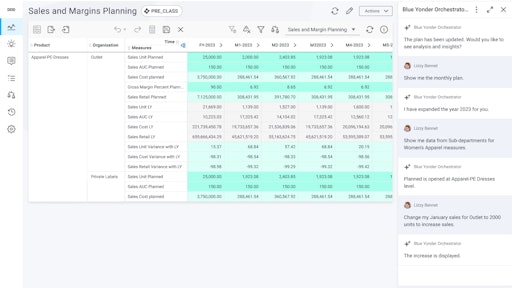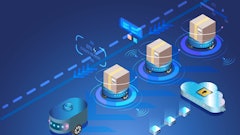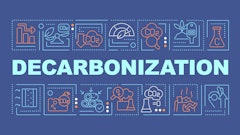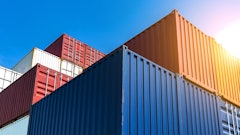
2024 is projected to be the year for major adoption and implementation of warehouse automation.
Thankfully, these true problem-solving solutions are prepping cold food chains for anything and everything.
Food Logistics talks exclusively with Ann Marie Jonkman, senior director, global industry strategies, Blue Yonder, about the future of warehouse execution systems and how having visibility into real-time data from every point of the operation is imperative for enhancing adaptability.
CLICK HERE to read the article in full.
Food Logistics: Warehouse automation continues to be on the rise. What do you think is attributing to the growth in adoption of automated warehousing?
Ann Marie Jonkman: The consumer palette is shifting in favor of fresher products – with a higher demand for fresh produce and prepared foods. Consumers want food that is as close to “farm to table” as possible. That demand creates a greater need for speed and accuracy in warehouses to ensure products are still fresh when they reach consumers and provide visibility to lot, date codes, expire dates, and origins of the items. There are also new ways to deliver those foods through subscriptions boxes, direct-to-consumer (D2C), and buy-online-pickup-in-store (BOPIS). Since 2020, D2C food delivery has grown immensely, meaning warehouses are often the final stop in food products’ journey before they reach the customer.
On top of those trends, we’re seeing a lack of skilled labor available for warehouses, an increased focus on sustainability, and the need to maintain food and worker safety. With the integration of artificial intelligence (AI), companies can offset labor shortages by automating tasks that don’t need direct involvement from workers. Solutions that use generative AI, in particular, allow businesses to quickly access recommendations and predictive insights that support intelligent decision making, which goes a long way in supporting sustainability and safety measures.
Food Logistics: What kinds of automated solutions/technologies has your company introduced within the last 12 months? Anything on the horizon that will be introduced soon?
Jonkman: Blue Yonder’s warehouse execution system acts as the brain of the warehouse, synchronizing tasks and data, and making AI- and machine learning-directed decisions. It orchestrates warehouse processes, material handling equipment, and robotics in a centralized hub. Warehouse execution system allows our clients to trial multiple automation technologies and determine which work best for their particular business mix without losing sight of their own business processes that make them unique. They can also quickly ramp up and down capabilities within the solution as they need them and interleave robotics automation with labor for efficient task management. The speed of physical automation is picking up but some studies indicate that about 80% of warehouses are not automated at all, making this an important competitive imperative.
The Blue Yonder yard management solution incorporates cameras, OCR, and machine learning (ML) to increase yard efficiencies and decrease detention and frustration. Increased visibility to inventory statuses and greater coordination and native connectivity with the Blue Yonder warehouse management solution (WMS) helps with effective dock scheduling and unloading.
- Launch of the first set of interoperable solutions across the entire supply chain – from planning to warehouse, transportation, and commerce – delivered on the company’s Luminate Cognitive Platform.
- Highlights for the logistics industry include always-on warehouse management, which builds upon Blue Yonder’s industry-leading warehouse capabilities with upgrade-safe extensibility and zero downtime during upgrades to ensure customer warehouses will stay online. The company is also highlighting strategic capabilities and enhancements in its fulfillment and logistics solutions, including transportation optimization, transportation manager, warehouse labor management, adaptive fulfillment and warehousing, yard management, billing management, and more.
- Launch of Blue Yonder Orchestrator, a generative AI capability that allows companies to fuel more intelligent decision-making and faster supply chain orchestration.
Food Logistics: What advice do you have for those companies who haven’t implemented any automation whatsoever or are just starting the journey? Where/how should they start?
Jonkman: First and foremost, companies need to ensure that they’re complying with food safety and regulations in order to reduce their risk. To do this they need active quality control and the ability to provide visibility, inventory management and temperature monitoring. All warehouses that handle food need to comply with the Food Safety Modernization Act (FSMA), and with the right, secure solutions they can automate back-office processes, lot expire and shelf-life tracking, and temperature controls throughout the items journey. More broadly, it’s important to implement solutions that leverage AI to become current and avoid falling behind competitors and the industry. Supply chain challenges and disruptions have become more prevalent in the last few years, and companies need to make informed decisions faster and pivot quickly to run their business efficiently. New advancements in AI and cloud, for example, can help by bringing value to data that’s often disparate, allowing for streamlined decision-making.
Companies should also focus on implementing automation in ways that have the most impact on improving safety of employees and food, as well as quality efficiency. For example, if there’s machinery that’s dangerous to operate, can you introduce automated controls to add an extra layer of security for workers? Can you incorporate robotics for lifting heavy objects? Looking at your standards and goals, consider where automation can simplify compliance and fill in gaps in achievement. How does that journey tie to your labor, business plans, and values for the company. Have a plan on your goals and objectives but also know your peaks, seasonal promotions, and labor trends.
Food Logistics: How can companies decipher which automated solutions are best for their warehouses?
It depends on which sub-vertical a company specializes in, but companies should look for the solutions that best address their most frequent challenges. For an e-commerce warehouse that handles orders of packaged food, maybe their main challenge is having enough labor to handle order peaks. In this case, they may want to opt for an automated solution that predicts peaks and recommends staffing schedules, or an automated picking solution to supplement gaps in labor.
It's also important to look for solutions that support sustainability efforts. In the cold food chain, many warehouses are using ammonia-based freezer and refrigeration systems to reduce energy usage. There are also automated temperature tracking and control solutions that ensure cold food products remain at a safe temperature to prevent spoilage and waste.
There are opportunities to incorporate automation into the facility that can benefit overall operations. Each warehouse will also have its own physical aspects – like lights, cameras, conveyors, lifts, and HVAC equipment – that an automated solution can monitor to ensure the whole facility is running as efficiently as possible.
Food Logistics: In your opinion, which are the best types of automated solutions and why? Think AI, cloud-based, IoT, connectivity and more.
Jonkman: Using devices like RFID and sensors for real-time, connected tracking at a pallet or case-level is one of the best automated solutions for improving accuracy, ensuring safety, and supporting sustainability goals. The best example is in dealing with a recall. If you have a shipment of lettuce that was recalled, case-level tracking allows you to quickly identify the exact units that need to be destroyed, which cuts down on food waste. Tracking at that level also allows you to find exactly where the affected units are within your facility and quickly pull them, saving time for workers to focus on more complicated tasks.
Our wave of AI-enabled warehouse execution system, yard management system, and transportation optimization solutions are expanding the opportunities to improve decision-making, efficiencies, profitability, and sustainability for cold chain operations.
In addition, generative AI and large language model (LLM) solutions are a gamechanger for warehouses. They can aggregate all of a facility’s data and deliver predictive insights and recommendations, like flagging when a machine is due for upcoming maintenance well ahead of it breaking down or predicting times of peak volume and offering staffing recommendations.
Food Logistics: What are some things not addressed above that may be pertinent to our cold food chain readers?
Jonkman: In the cold food chain, it’s critical to think about all of the data involved in warehouse operations holistically. Having an end-to-end platform in the cloud that allows you to see all operations to connect your data, devices, people, and physical infrastructure will mature your supply chain and how you interact with customers, consumers and suppliers. Using the insights to drive changes for the better, whether that is quality, labor and customer service. There are always going to be unexpected situations that come up in any cold food chain, but having visibility into real-time data from every point of the operation is imperative for enhancing adaptability. Incorporating tools like AI, ML, and advanced algorithms into your strategy can also help predict and offer solutions for roadblocks, helping to ensure safety and drive efficiency in your warehouse.
CLICK HERE to read the article in full.


























